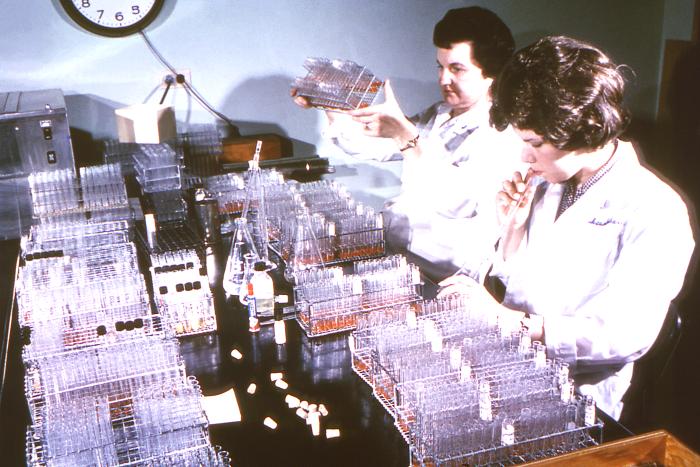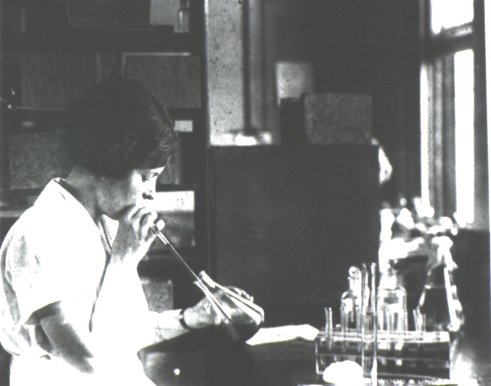Today, cheap and accurate mechanical pipettes are used by clinical pathology laboratories, although mouth pipetting, a dangerous medical lab practice, is still used in developing nations
Mouth pipetting was the topic of a recent blog published by Body Horrors. The blogger recalled a time when clinical laboratory professionals routinely mouth pipetted specimens.
Mouth pipetting is the practice of using one’s mouth to suck a desired volume of a medical laboratory specimen–blood, urine, cell cultures and other microbial stews–into an open-ended tube, using the reduced air pressure created by sucking to hold the specimen in place while moving it to another vessel.
Older Clinical Laboratory Professionals Remember Mouth Pipetting
Medical technologists, medical laboratory technicians, and pathologists who worked during that era will find this blog post to be a humorous walk down memory lane. The blog post was written by Rebecca Kreston, a microbiologist and infectious disease scholar and could be a candidate for the TV series Fear Factor.
Mouth pipetting “was more than a common sight, it was a way of the lab,” noted Kreston in her blog post. This commonplace practice only came to an end in the 1970s, when cheap mechanical pipettes became available.
Once the Leading Source of Laboratory-Acquired Infections
This may sound strange and dangerous to the younger medical technologists (MTs) and clinical scientists (CLSs) working in today’s highly-regulated medical laboratory environment.
After all, they regularly use sophisticated pipette devices that are perfectly calibrated to move precise amounts of specimens from one vessel to another. Plus, the safety-conscious clinical laboratory professionals today may have a hard time comprehending a time when mouth pipetting was routine practice.

In a photo typical of times long past, mouth pipetting is featured. Pictured here is former Centers for Disease Control (CDC) parasitologist, Dr. Mae Melvin (left). She is examining a collection of test tubes while her laboratory assistant mouth pipettes a culture to be added to these test tubes. (Photo source: David Senser/CDC.)
Medical Laboratory Mouth Pipetting Stories from Years Past
Kreston’s blog was shared on the MEDLAB-L Listserv and elicited plenty of stories and comments from medical laboratory professionals who worked during that time. They recalled their misadventures with mouth pipetting—some humorous, some not—prior to the appearance of AIDs in 1978.
Canadian blogger Pat Letendre wrote: “I’m old enough to have done it at a blood centre/ transfusion service in days before HIV/AIDS, but we did have HBV. All stopped when two chemistry technologists in Saskatchewan, Canada got hepatitis B from mouth pipetting quality control samples.”
Karen Baker of Stark State College in Canton, Ohio, said: “When I did some training at the Minnesota Department of Health in the 70’s, they were mouth pipetting SHIGELLA!”
One Mouth Pipette Used for Entire Run of Different Patients
Warren Coffin of CKHS Taylor Hospital in Ridley Park, Pennsylvania: recalled: “I remember in ’71 at Naval Hospital San Diego 8417 Lab Tech School, an HM2 instructor telling us about his mouth pipetting exploits when he was in Lab School in the ’60s. No one could figure why he had so many positive VDRLs compared to the other students that rotated through serology. Turns out he was using one pipette for a run of patients. He claimed no one told him ‘one pipette for each patient’.”
Kathleen K.B. Crown, formerly a medical technologist who is now a Financial Analyst at Cornell University, credits pipetting for her immunity to HepB: “Pipetting sed rates in those long glass tubes…phone rang, startled me and I gulped…ugh. Maybe contributed to my mysteriously solid HepB immunity, with no disease.”
Harlan Akers, a medical technologist and retired lab director, recalled: “The craziest thing I ever pipetted by mouth was chloroform. It actually tastes sweet. Luckily I never fell asleep on the job.”
Mike Long of Bozeman, Montana, wrote: “Speaking of the old days….I used to regularly watch a woman smoke a cigarette while pipetting ether by mouth. She never missed a beat. They don’t make [med] techs like that any more, which is probably just as well.”
[Read more of these stories at: http://bodyhorrors.wordpress.com/2013/03/20/mouth_pipetting/.]
History of Mouth Pipetting Accidents in Clinical Laboratories
The first recorded case of accidental infection occurred in 1893, when a physician accidently sucked a culture of typhoid bacilli into his mouth. But Kreston noted that the history on pipetting techniques is sparse—itself a shocking shortcoming—and that makes it difficult to generalize about the prevalence of this phenomena.
But what is documented is the frequency of ridiculous accidents resulting from mouth pipetting. A survey of 57 labs in 1915 found 47 infections associated with workplace practices, of which 40% were attributed to swallowing a corrosive or toxic substance or infectious lab specimen. A longitudinal study of 921 workplace laboratory infections between 1893 and 1950 found 17% were due to “oral aspiration through pipettes or to splashes of culture fluids into the mouth.”

A woman mouth pipetting to select specimens of ectoparasites. (Photo Source: National Library of Medicine.)
In fact, infection through the use of one’s oral cavity to process specimens was such an occupational hazard that, in 1966, the U.S. Army Biological Laboratories published an article on The Hazards of Mouth Pipetting.” The authors pointed out that the “method of avoiding pipetting hazards is so elementary, so simple, and so well-recognized that it seems redundant to mention it.”
Mouth pipetting was abandoned for the most part in the 1970s. That is when cheap, mechanically adjustable pipettes—which are safer and far more accurate than mouth pipettes—flooded the market. Although explicitly banned, occasional mouth pipetting accidents are still reported nationally.
For example, one 19-year-old nursing student was hospitalized in 1998 after becoming infected with a unique strain of Salmonella paratyphi. She had been working with a specimen of this bacteria in a lab. The case report suggested that the culprit behind this microbial misadventure was mouth pipetting, added Kreston in her blog, which also noted that mouth pipetting is still a common practice in medical laboratories in developing nations.
—Patricia Kirk
Related Information:




Does anyone have a good example of a written procedure on how mouth pipetting was to be “properly” performed in the laboratory?
Ah yes! those were the days! I enjoy occasionally regaling the young whipper-snappers with tales of the old days – mouth pipetting (mouthful of blood? spit it out; don’t make a fuss); breaks? put your lunch & coffee on the bench so you can have it as you work; PPE? what’s that? I remember when I was a new trainee we still used glass syringes, and blood was dispensed into glass tubes with rubber stoppers. When the washing-up person was on leave, that job fell to the newest trainee – me! The glass test tubes had to be washed every day, so all the clots were shaken out of the tubes and squished down the plughole! I could go on and on and on …
Thank-you for the article about mouth pipetting and the comment by Pat Letendre of the two technologists that contracted Hepatits B in Saskatchewan in the 1970s.
I was reviewed biosafety concerns with new pathology residents last fall at Royal University Hospital in Saskatoon. We discussed this topic in the hallway in front of the memorial plaque for those technologists
that died in that incident. It wasn’t so long ago and it’s worthwhile pointing out the impact the lessons learned along the road to safer lab practices.
Thanks for this great summary of my article, Dark Daily! I had a lot of fun writing it and delight in hearing some of the personal mouth pipetting stories that the article has elicited.